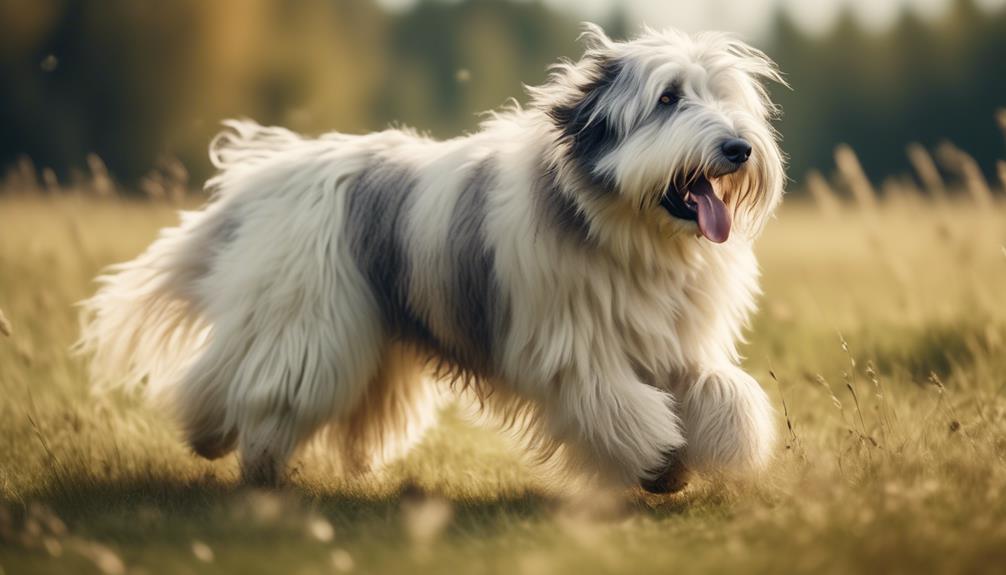
Is it possible that the Polish Lowland Sheepdog, also known as PON, has a fascinating and mysterious history?
While many theories exist about the origins of this breed, one particular theory suggests that the Huns played a significant role in spreading the PON to different countries.
As intriguing as this theory may be, there is much more to discover about the Polish Lowland Sheepdog, from its adaptability to apartment living to its distinctive appearance and health considerations.
Whether you are a potential owner or simply curious about this beloved breed, there is a wealth of information waiting to be uncovered.
Key Takeaways
- The Polish Lowland Sheepdog, also known as PON, is a medium-sized herding dog originating from Poland.
- They are adaptable to apartment living and are suitable for novice owners, but consideration of neighbors and their energy levels is important.
- The breed is affectionate with family, good with other dogs, and protective of their flock.
- Regular grooming is necessary for their shaggy double coat, and they may be prone to certain hereditary health conditions.
Origin and Breed Group
The Polish Lowland Sheepdog, originating from Poland, falls under the herding breed group. This medium-sized dog weighs between 35-55 pounds and has a lifespan of 12-15 years. It’s known for its adaptability to apartment living, making it a desirable choice for novice owners. When choosing a dog for an apartment, size isn’t the only factor to consider. Energy levels and space requirements should also be taken into account, as well as the dog’s qualities such as being quiet and low-energy to ensure the comfort of neighbors.
In terms of friendliness and training, the Polish Lowland Sheepdog is affectionate with family, good with other dogs, and protective of their flock. Early and consistent training is recommended for this intelligent and loyal breed. In terms of appearance, the Polish Lowland Sheepdog is a medium-sized, long-haired dog with a shaggy double coat and bushy eyebrows. The coat can come in various colors, including white, gray, and black. Regular grooming is necessary to prevent matting, although they’re relatively low-shedding.
When it comes to health and history, the Polish Lowland Sheepdog is generally a healthy breed, but can be prone to hereditary health conditions such as hip dysplasia and progressive retinal atrophy. Regular veterinary check-ups are essential. This adaptable breed requires ample exercise and mental stimulation. It’s descended from the Puli, Tibetan Mastiff, Tibetan Spaniel, Lhasa Apso, and Tibetan Terrier. There’s a possible theory of the Huns spreading the breed to different countries.
Polish merchant Kazimierz Grabski exchanged Polish Lowland Sheepdogs for Scottish sheep, which were then used to crossbreed with Scottish dogs to develop the Bearded Collie. During World War II, Dr. Danuta Hryniewics saved the breed with her dog Smok.
Size and Lifespan
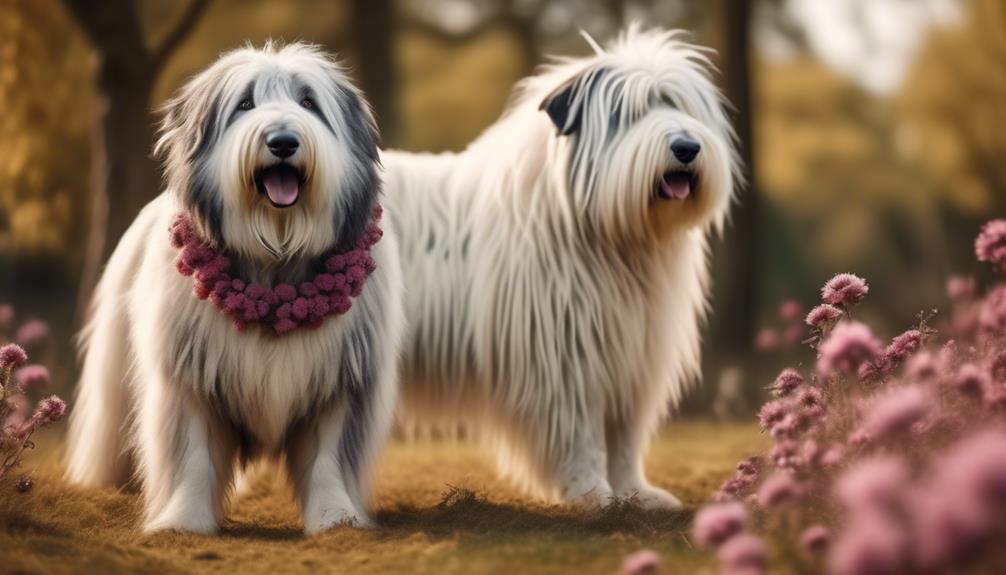
Originating from Poland and falling under the herding breed group, the Polish Lowland Sheepdog is a medium-sized dog with a lifespan of 12-15 years and weighs between 35-55 pounds. This breed’s size and lifespan make it a suitable companion for those looking for a long-term furry friend. The Polish Lowland Sheepdog’s size allows it to be adaptable to various living situations, including apartment living. Despite its medium size, this dog requires ample exercise and mental stimulation to thrive. Regular veterinary check-ups are also essential to ensure the health and well-being of this breed. Below is a table summarizing the size and lifespan of the Polish Lowland Sheepdog:
| Size | Lifespan |
|---|---|
| Medium | 12-15 years |
| 35-55 lbs |
Adaptability to Apartment Living
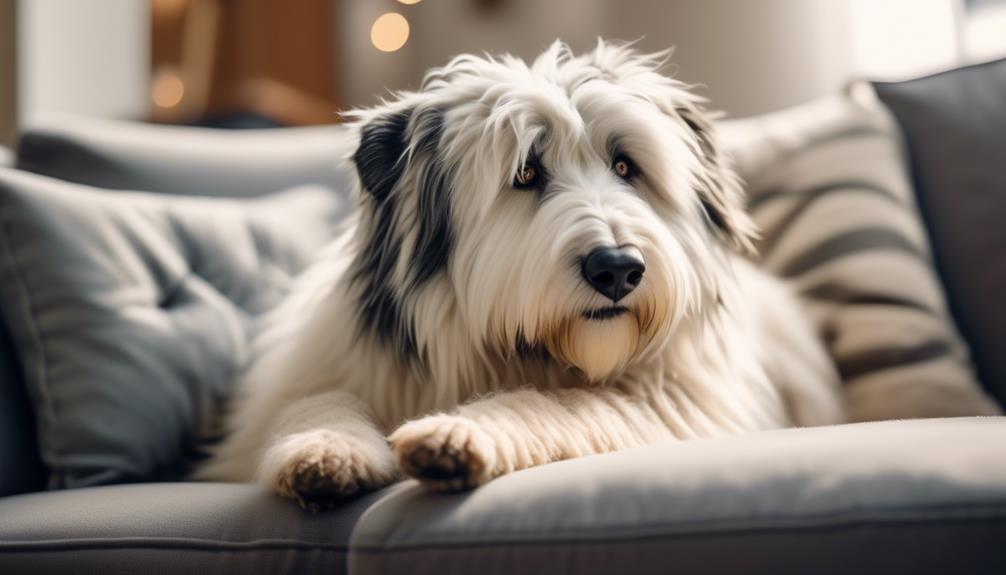
The Polish Lowland Sheepdog excels in adapting to apartment living due to its manageable size and low energy levels. Despite being a medium-sized breed, their compact build makes them well-suited for living in smaller spaces. Additionally, their low energy levels mean they don’t require excessive exercise, making them a good fit for apartment dwellers.
However, it’s important to consider the needs of the neighbors and create a harmonious living environment. While size is a factor to consider when choosing a dog for an apartment, it’s equally important to prioritize qualities such as being quiet and low-energy.
With their adaptable nature and easygoing temperament, the Polish Lowland Sheepdog is a great choice for apartment living.
All-around Friendliness and Training
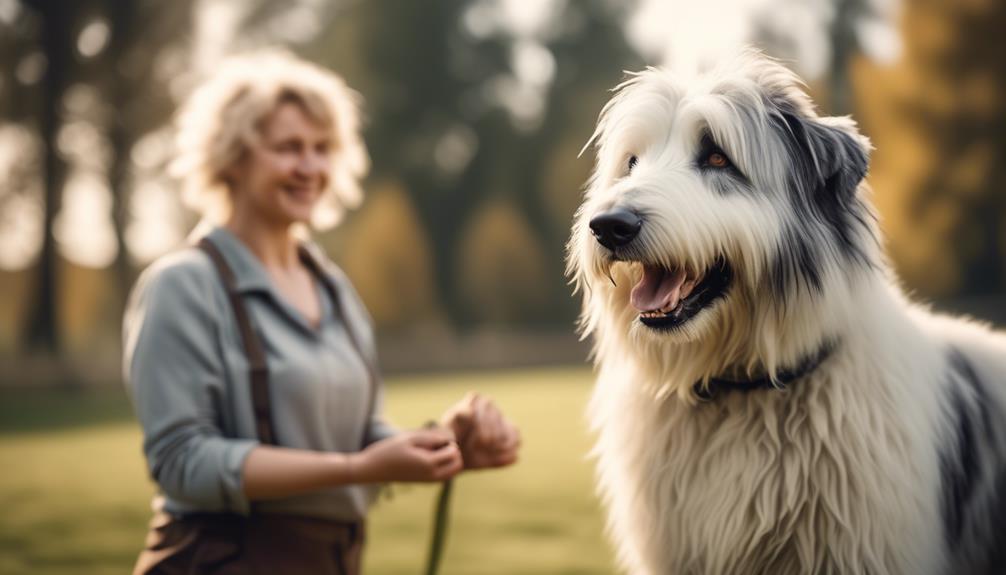
After discussing the Polish Lowland Sheepdog’s adaptability to apartment living, let’s now explore its all-around friendliness and training.
This breed is known to be affectionate with their family and good with other dogs. They’ve a protective nature, especially when it comes to their flock. Polish Lowland Sheepdogs are intelligent and loyal, making them great companions.
Early and consistent training is recommended for this breed to ensure they develop good behavior and manners. They’ve strong herding instincts, so it’s important to provide them with mental stimulation and exercise.
With their distinctive appearance and shaggy double coat, regular grooming is necessary to prevent matting.
Characteristics and Appearance
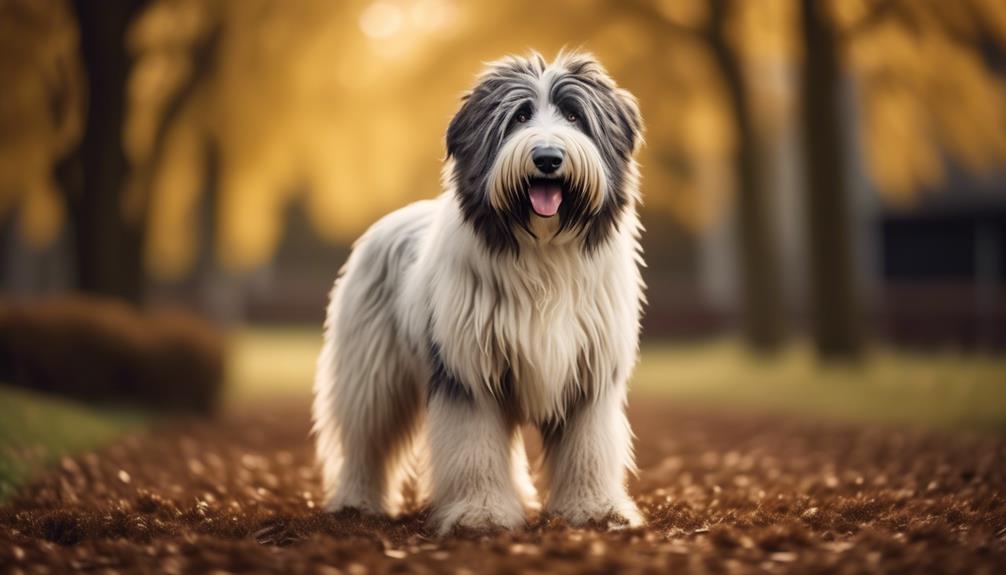
With a medium size and long-haired coat, the Polish Lowland Sheepdog, also known as PON, is a distinctive breed originating from Poland. This breed possesses several unique characteristics and appealing physical features:
- Shaggy double coat with bushy eyebrows
- Coat can be various colors, including white, gray, and black
- Recognizable by its distinctive appearance
- Strong herding instincts and loyal personality
- Relatively low-shedding
The PON’s shaggy double coat, coupled with its expressive bushy eyebrows, gives it a charming and distinctive appearance. The coat comes in various colors, adding to its visual appeal.
Apart from its striking physical features, the PON is known for its strong herding instincts and unwavering loyalty. Additionally, this breed is relatively low-shedding, making it a suitable choice for individuals who prefer a dog with minimal shedding.
Health and History
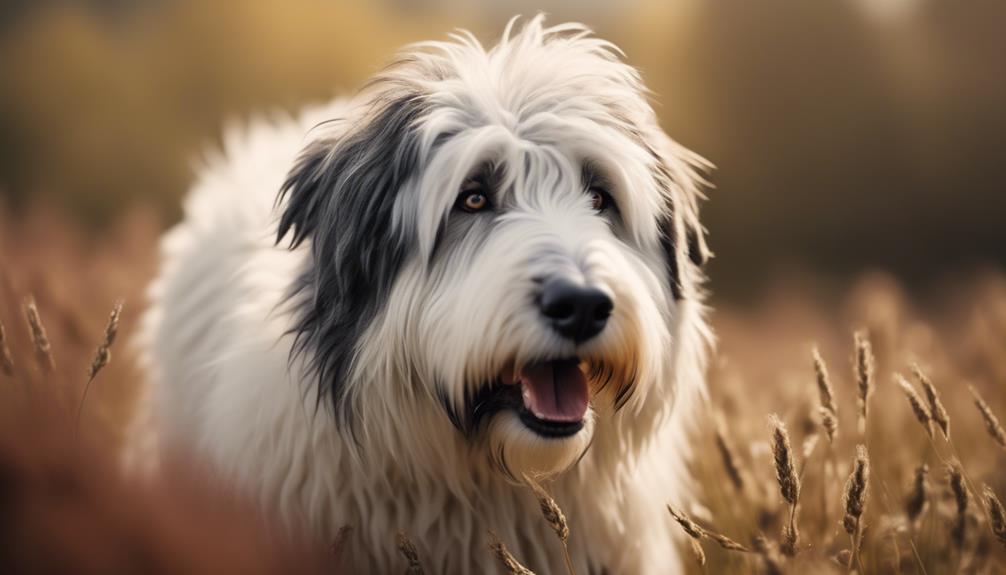
Continuing the exploration of the Polish Lowland Sheepdog’s characteristics and appearance, its health and history reveal interesting insights into this breed’s origins and potential health concerns. Generally, the Polish Lowland Sheepdog is a healthy breed, but like many dogs, it can be prone to hereditary health conditions such as hip dysplasia and progressive retinal atrophy. Regular veterinary check-ups are essential to ensure their overall well-being. Descended from the Puli, Tibetan Mastiff, Tibetan Spaniel, Lhasa Apso, and Tibetan Terrier, the Polish Lowland Sheepdog has a rich and diverse history. It is believed that the breed was spread to different countries by the Huns. Polish merchant Kazimierz Grabski played a significant role in the breed’s development by exchanging PONs for Scottish sheep, which were then used to crossbreed with Scottish dogs to create the Bearded Collie. Additionally, during World War II, Dr. Danuta Hryniewics saved the breed from extinction with her dog Smok.
| Health | History |
|---|---|
| Generally healthy | Descended from the Puli, Tibetan Mastiff, Tibetan Spaniel, Lhasa Apso, and Tibetan Terrier |
| Prone to hip dysplasia and progressive retinal atrophy | Possible theory of Huns spreading the breed to different countries |
| Regular veterinary check-ups recommended | Polish merchant Kazimierz Grabski’s role in breed development |
| Requires ample exercise and mental stimulation | Dr. Danuta Hryniewics saving the breed during World War II |
Grooming and Shedding
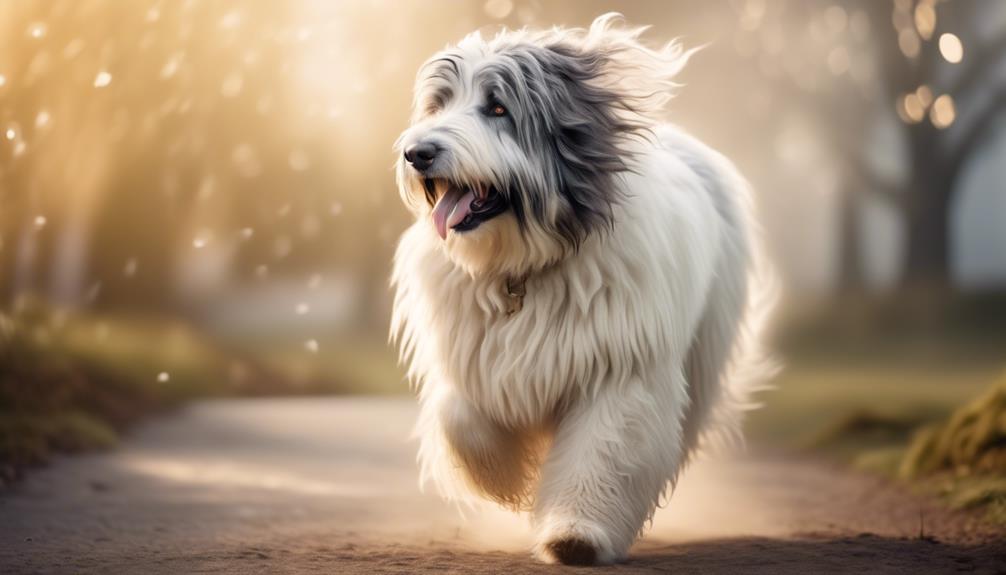
To maintain the Polish Lowland Sheepdog’s distinctive appearance and prevent matting, regular grooming is necessary. This breed has a shaggy double coat with bushy eyebrows, and while it’s relatively low-shedding, it still requires attention to keep its coat in optimal condition. Here are some important points to consider about grooming and shedding in Polish Lowland Sheepdogs:
- Brushing: Regular brushing is essential to prevent matting and tangles in the long, dense coat.
- Bathing: Occasional baths are recommended to keep the coat clean and healthy.
- Trimming: Regular trimming of the hair around the eyes, ears, and paws is necessary to maintain hygiene and prevent irritation.
- Professional Grooming: Many owners opt for professional grooming to ensure that their dog’s coat is properly maintained.
- Shedding: While the Polish Lowland Sheepdog isn’t a heavy shedder, some shedding can still occur, so regular brushing helps to control loose hair.
Importance of Regular Veterinary Check-ups
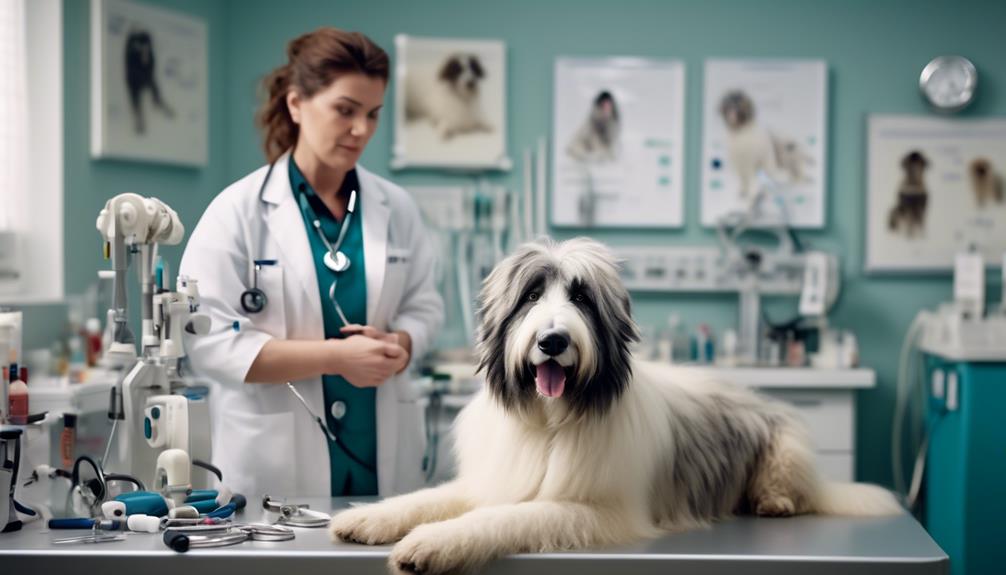
Regular veterinary check-ups are crucial for maintaining the health and well-being of Polish Lowland Sheepdogs. These check-ups allow veterinarians to monitor the overall health of the dogs, identify any potential health issues early on, and provide appropriate treatment or preventive measures.
Due to their hereditary health conditions, such as hip dysplasia and progressive retinal atrophy, regular check-ups are even more vital for Polish Lowland Sheepdogs. During these check-ups, the veterinarian can perform a thorough physical examination, assess the dog’s weight and body condition, check for any abnormalities or signs of illness, administer necessary vaccinations, and discuss any concerns or questions the owner may have.
Frequently Asked Questions
Are Polish Lowland Sheepdogs Good With Children?
Polish Lowland Sheepdogs are generally good with children. They are affectionate, loyal, and protective of their family. Early and consistent training is recommended to ensure a harmonious and safe interaction between the dog and children.
How Much Exercise Do Polish Lowland Sheepdogs Need?
Polish Lowland Sheepdogs require a moderate amount of exercise to keep them healthy and happy. Regular walks, playtime, and mental stimulation are necessary to meet their energy needs.
Do Polish Lowland Sheepdogs Bark a Lot?
Polish Lowland Sheepdogs can bark a lot if not properly trained and socialized. They have strong protective instincts and may bark to alert their owners of potential threats. Consistent training and socialization can help manage their barking tendencies.
Are Polish Lowland Sheepdogs Prone to Separation Anxiety?
Polish Lowland Sheepdogs can be prone to separation anxiety. It is important for owners to provide them with proper mental stimulation and exercise, as well as gradually acclimating them to being alone to prevent this issue.
Can Polish Lowland Sheepdogs Be Left Alone for Long Periods of Time?
Yes, they can be left alone for long periods of time, but it is not recommended. Polish Lowland Sheepdogs are social and thrive on human companionship. They may develop separation anxiety if left alone for extended periods.
Conclusion
In conclusion, the Polish Lowland Sheepdog, or PON, is a versatile and loving breed that makes an excellent companion for families and individuals alike. With their intelligence and loyalty, they’re highly trainable and adaptable to various living situations, including apartments.
Their distinctive appearance and low-shedding coat require regular grooming, but their overall health and history make them a cherished breed. Regular veterinary check-ups are essential for maintaining their well-being.
The PON’s long and rich history adds to their charm and appeal as a beloved companion and working dog.




